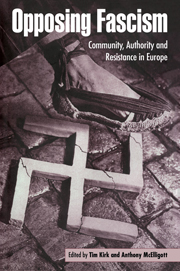Book contents
- Frontmatter
- Contents
- List of contributors
- Preface
- Introduction: Community, authority and resistance to fascism
- 1 The German revolution defeated and fascism deferred: the servicemen's revolt and social democracy at the end of the First World War, 1918–1920
- 2 Dangerous communities and conservative authority: the judiciary, Nazis and rough people, 1932–1933
- 3 The anti-fascist movement in south-east Lancashire, 1933–1940: the divergent experiences of Manchester and Nelson
- 4 Spain 1936. Resistance and revolution: the flaws in the Front
- 5 The Blueshirts in the Irish Free State, 1932–1935: the nature of socialist republican and governmental opposition
- 6 Town councils of the Nord and Pas-de-Calais region: local power, French power, German power
- 7 Structures of authority in the Greek resistance, 1941–1944
- 8 Nazi Austria: the limits of dissent
- 9 ‘Homosexual’ men in Vienna, 1938
- 10 ‘The years of consent’? Popular attitudes and forms of resistance to Fascism in Italy, 1925–1940
- 11 Saints and heroines: rewriting the history of Italian women in the Resistance
- Notes
- Index
7 - Structures of authority in the Greek resistance, 1941–1944
Published online by Cambridge University Press: 28 July 2009
- Frontmatter
- Contents
- List of contributors
- Preface
- Introduction: Community, authority and resistance to fascism
- 1 The German revolution defeated and fascism deferred: the servicemen's revolt and social democracy at the end of the First World War, 1918–1920
- 2 Dangerous communities and conservative authority: the judiciary, Nazis and rough people, 1932–1933
- 3 The anti-fascist movement in south-east Lancashire, 1933–1940: the divergent experiences of Manchester and Nelson
- 4 Spain 1936. Resistance and revolution: the flaws in the Front
- 5 The Blueshirts in the Irish Free State, 1932–1935: the nature of socialist republican and governmental opposition
- 6 Town councils of the Nord and Pas-de-Calais region: local power, French power, German power
- 7 Structures of authority in the Greek resistance, 1941–1944
- 8 Nazi Austria: the limits of dissent
- 9 ‘Homosexual’ men in Vienna, 1938
- 10 ‘The years of consent’? Popular attitudes and forms of resistance to Fascism in Italy, 1925–1940
- 11 Saints and heroines: rewriting the history of Italian women in the Resistance
- Notes
- Index
Summary
The limitations of a purely political approach to the history of the resistance in Greece have only become apparent with the end of the Cold War. For a long time, historians of both left and right focused on elite politics and saw authority in the main resistance movement, EAM/ELAS (Ethniko Apeleftherotiko Metopo – National Liberation Front/Ethnikos Laikos Apelftherotikos Stratos – Greek People–s Liberation Army), as emanating from the top down. The British agent and historian C. M. Woodhouse, in 1948, insisted upon the ‘horizontal division’ between ‘leaders and the led’: above the line were the ‘politically conscious’, below it ‘the undiVerentiable mass of Greek humanity’. Rarely articulated so clearly, this view has underpinned the research agenda through to the 1980s. But as a sensitive commentator pointed out in a review of Woodhouse's book which most comprehensively synthesised this tradition, Apple of Discord, to focus extensively upon politics risked ignoring the social and economic origins of resistance activity, and thereby misunderstanding its nature. It was all too easy to recast the events of a highly fluid and uncertain epoch in terms of the rigid polarities of the subsequent Cold War.
I have attempted elsewhere to adumbrate an alternative approach to the history of EAM/ELAS. In not dissimilar vein, Georgios Margaritis has shown how events which have little to do with party politics – the experience of the Albanian campaign in 1940–41, the collapse of the state, food shortage and black marketeering – led to the tremendous social transformation behind the emergence of mass resistance.
- Type
- Chapter
- Information
- Opposing FascismCommunity, Authority and Resistance in Europe, pp. 120 - 132Publisher: Cambridge University PressPrint publication year: 1999

